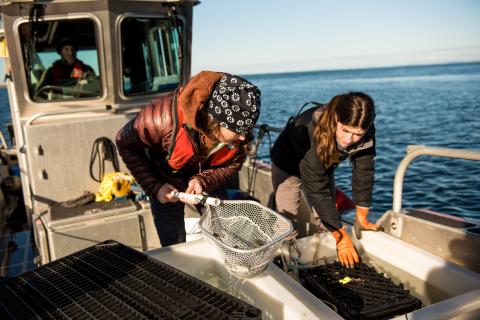Fish Mesocosm Study
The Triton Fish Mesocosm Study was a collaboration between PNNL, the University of Washington, University of Alaska Fairbanks, and the University of Maine. The project acted as a pilot study to determine the efficacy of using Juvenile Salmon Acoustic Tracking System (JSATS) fish tagging technology combined with the University of Washington’s 3G Adaptable Monitoring Package (3G AMP) to determine fish movement and habitat usage in a natural environment where a tidal device might be placed. The AMP—equipped with sonar, acoustic cameras, hydrophones, and a classification system–was deployed in the presence of a strategically installed JSATS hydrophone array at a location in Sequim Bay, Washington, where a tidal turbine was scheduled to be installed.
Over 100 sablefish (Anoplopoma fimbria) were tagged with JSATS acoustic transmitter tags and were tracked after controlled released around the AMP. The advanced PNNL JSATS tagging technology created fine spatial and temporal resolution fish tracks after release. Combining these tags with the AMP’s multi-sensor technology allowed for detailed observation of the behavior of fish in the presence of an active sensor package.

The first phase of the pilot effort showed promising results. The tracking efficiencies of the hydrophone beacon array was high and any acoustic transmissions from devices on the AMP were not found to affect the tracking efficiency significantly. Of the 108 tagged fish that were released, 103 were detected by the hydrophone array after release. A total of 97 percent of the detected fish were tracked in three-dimensions and 62 were tracked within one minute of release. Thirty-seven (60 percent) swam toward the AMP, 25 (40 percent) swam away from it, and only one fish came within 5 meters of the sensor package. This research was the first of its kind to successfully present the utility of JSATS tags coupled with a sensor package for fine-scale fish movement in an energetic tidal channel.
After the pilot tests, the project planned to repeat the experiment on a larger scale in the presence of a deployed turbine. Unfortunately, the turbine deployment was delayed indefinitely, and measurements were not able to be repeated. However, the study results verified a low probability of fish interaction with the AMP and demonstrated the ability reconstruct in situ fish movements around a device, laying the foundation for future studies to use similar methods to examine fish behavior around marine energy devices.
The results from the pilot study are published here: Using acoustic telemetry for high-resolution sablefish movement informing potential interactions with a tidal turbine